Battle office fatigue
When you’re stuck at a desk for eight-plus hours a day, your body can suffer, says Jim Heafner, a physical therapist based in Boulder, Colorado. He recommends performing exercises that reverse the negative side effects of the seated posture—the following moves can help keep you injury-free.
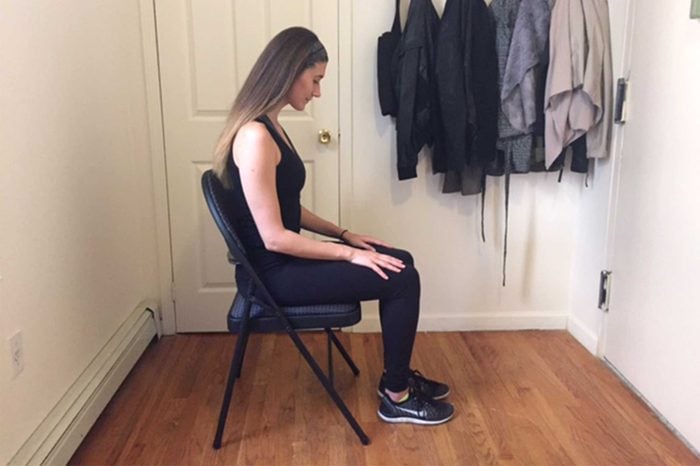
Chin tuck plus
Sometimes being deskbound is inevitable, and Heafner recommends performing exercises that reverse the negative side effects of the seated posture. To perform the chin tuck plus, Heafner says to sit in a tall, seated position with your hands resting on your thighs. Draw the chin in (“this will feel like you are giving yourself a double chin,” Heafner says) and expand through your chest, bringing the shoulders down away from your ears. Your gaze should lift toward the ceiling while keeping the chin drawn in. Do 15 repetitions every one to two hours while seated. Here’s how to help your body recover from a day of sitting.
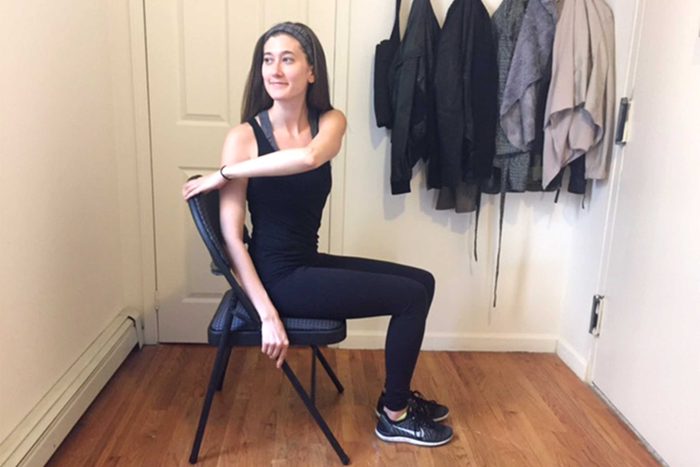
Yoga twists
Nicole Winhoffer, creator of the NW Method and a fitness artist who has worked with celebrities including Madonna, Rachel Weisz, and Stella McCartney, enjoys active stretches in the chair. She finds that many people aren’t rotating enough in their exercises. “When people are exercising, they’re only working the spine forward and backward and side to side, but they rarely rotate the trunk, and that increases blood flow through the spine, and it increases blood flow through the body,” Winhoffer says. “It releases synovial fluid all along the back, which is really important for lubrication of the joints and the bones.”
To do an active twist, sit with your back one inch away from the back of the chair and bring one arm to the opposite side of the chair. Grab onto the chair and begin to twist moving toward the arm, bringing your gaze behind you. Hold the twist for about three seconds, then release for three. Perform the twist 10 times on each side, twice a day. To do some yoga stretches right from your bed, check out these 7 energizing poses.
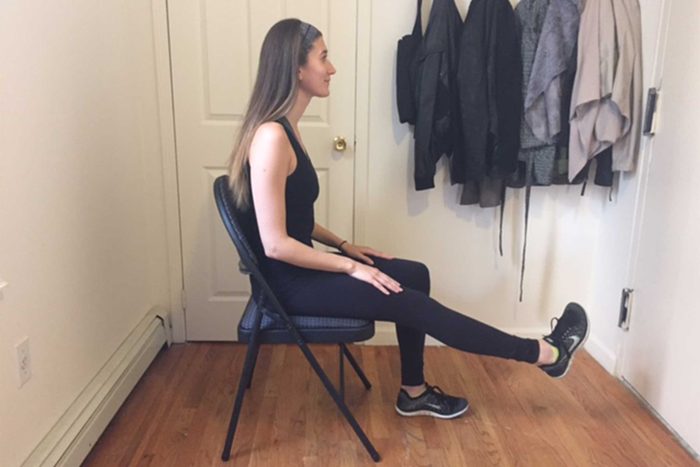
Ankle pumps/circles
A simple exercise, moving the ankles in a circular motion helps with movement in the ankle joints, contracting the lower leg muscles and pumping fluid out of the lower leg to keep these muscles more mobile, says Karena Wu, a physical therapist at ActiveCare Physical Therapy in New York, NY. “Keeping the joints and soft tissues mobile and flexible allow for improved movement patterns during functional activities [out of the chair],” she says. These types of stretches help relieve the lactic acid buildup that comes with more intense workouts, says Wu. She recommends doing these stretching exercises to help build a foundation, and these should be done for about 30 seconds at a time, a few times a day.
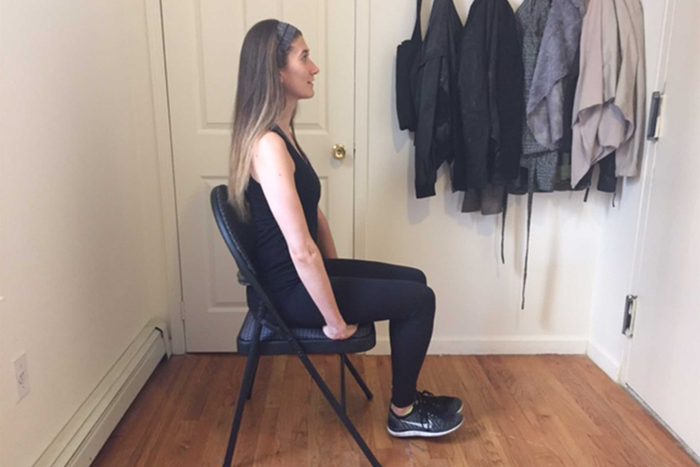
Knee lifts
Winhoffer says one of the biggest issues of being stuck in a chair is lower back pain, which can be brought on from the confinement. To help combat it, scoot toward the middle of the seat, bringing your thighs partway off of the chair. Both hands should be placed underneath you on the seat to open up your chest. Keeping the knees bent and together, bring both feet off of the floor. Continue to push your hands into the chair and hold in your belly button. Winhoffer says to bring your knees up for three seconds, then to lower and rest for three seconds. Doing this 10-20 times throughout the day helps to strengthen the core and bring awareness to the body. To advance the movement, straighten the leg instead of keeping it bent. Learn the surprising reasons you have back pain.
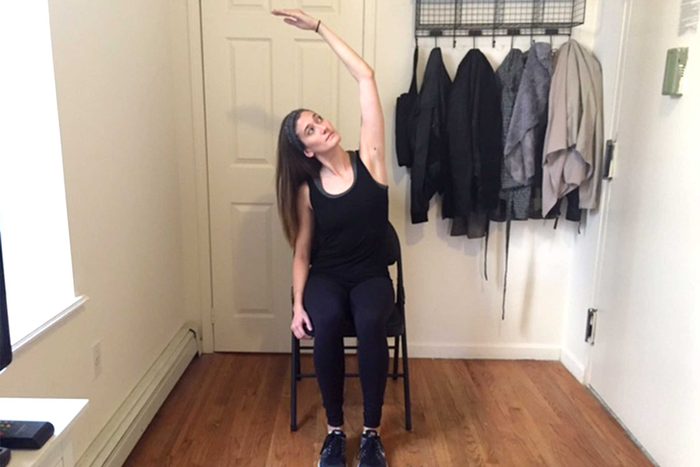
Trunk and hip stretches
Wu also recommends stretching the trunk of the body, including the abdominals and hips. Bringing one arm overhead at a time, bend toward the opposite side. After repeating the stretch on each side for 10-12 times, bring both arms overhead, relaxing the shoulders, and bend straight back to work the abdominal region. To stretch the hips, sit upright and cross one leg over the other and pull the knee towards the opposite shoulder (stretching the gluteus maximus). For a Figure 4 stretch, sit upright and place one ankle on top of the opposite knee. Keep your back straight and begin to lean the trunk forward, keeping feet flexed. Wu says she sees patients struggle with knowing their limits, so be careful not to overstretch an area, as this forces the tissue into a greater range of motion without the true ability for it to get there, she says. Sometimes this can lead to injuries.
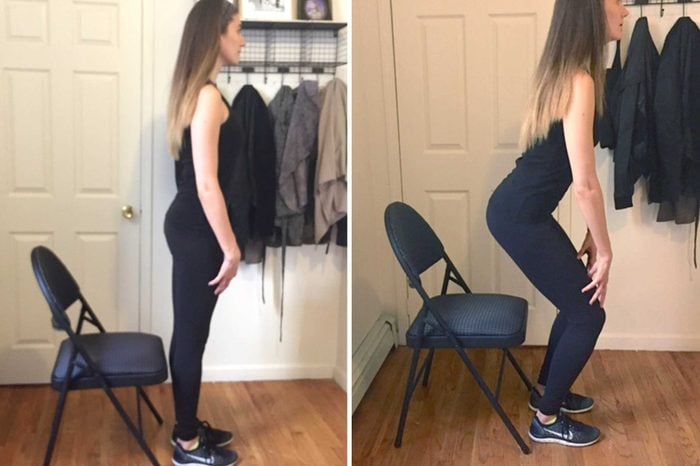
Sit-to-stand negatives
When Heafner educates patients on exercise and posture, the first thing he tells them is to “stand up!” He says the best posture is a dynamic one that is constantly changing. In a sit-to-stand negative, begin to stand up at a normal pace from your chair. Then, slowly sit back down over a three- to five-second period. “When lowering, stick your hips back and keep your knees tracking over your second toe,” Heafner recommends. Do 10 repetitions three to four times a day. Here are 7 other ways to improve your posture.
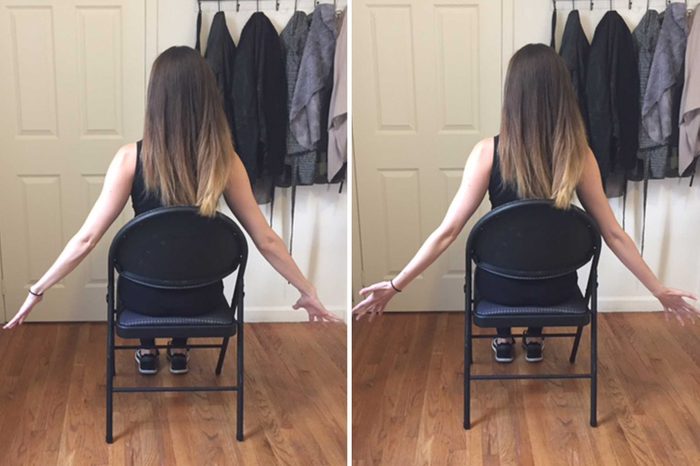
Postural reset
The postural reset, like the chin tuck plus, is a corrective movement that helps to open up the chest muscles, engage the shoulder muscles on the back of the body, and mobilize the middle portion of the spine. “Having a healthy and mobile spine prevents neck, low back, and shoulder pain,” Heafner says. “I often prescribe these movements for people who are required to sit for prolonged periods.” To prepare for the postural reset, sit upright with your back against your chair. Heafner says to flatten your low back, neck, and shoulders against the chair so that the spine is in a neutral position. From here, keeping your elbows by your sides, turn both shoulders out, leading with your thumbs. Perform 15 repetitions every couple of hours in your seated position.
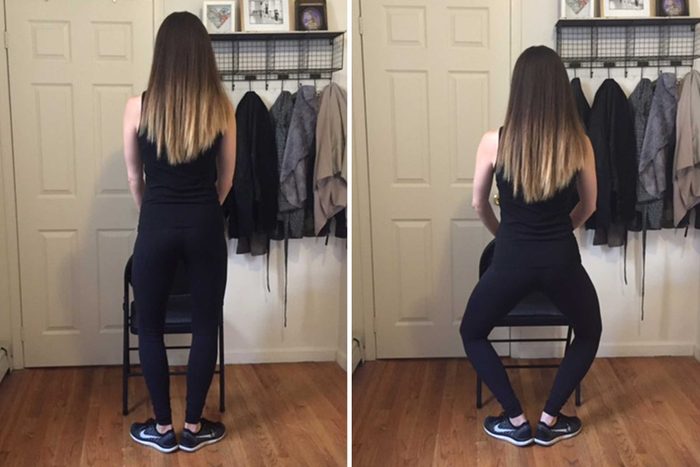
Plié
Samantha Burns, a trainer based in New York, NY, says finding creative ways to stretch, move, and engage your muscles will increase your energy levels and will make a big difference in how you feel. Standing behind the chair, place both hands lightly on the chair, using the back for light support. Start with your heels together and your feet slightly turned out from the hip. Engage your core and keep your chest slightly lifted as you begin to bend your knees. Be sure to keep your feet flat, pressing into the floor to initiate the movement, and then slowly straightening the knees. Continue this bend and stretch movement to stretch out the legs and improve overall circulation after being seated for a long time. This exercise also tones long lean muscles through the legs. Wondering why you’re so fatigued? It could be one of the 15 surprising things that drain your energy.
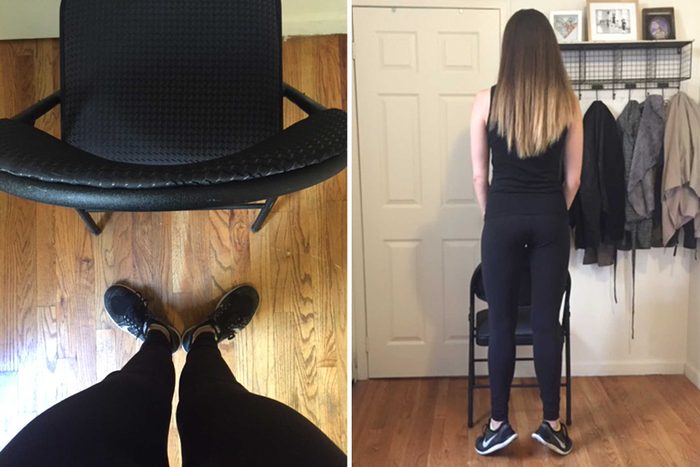
Relevé
Continuing to draw ideas from barre, stand behind the chair once again. Place both hands on the back of the chair and come to first-position—heels together and your feet slightly turned out. Keeping your chest lifted and shoulders relaxed, pull your stomach in. Press into the balls of your feet, and lift your heels off the ground, making sure to keep your legs straight and glutes engaged as you lower and lift your heels. “This is a great exercise to strengthen muscles when you have to wear high heels,” says Burns. “This exercise strengthens the muscles in your feet, calves, and legs… and helps ground you and calm you down if you are having a stressful day.” Next: If you struggle with neck pain, these moves will help.